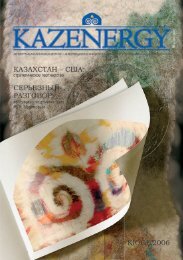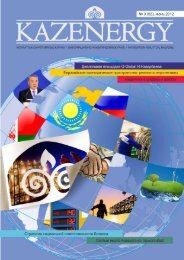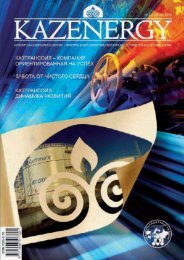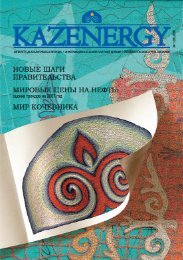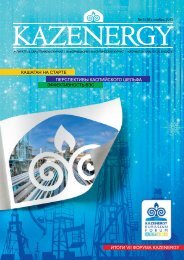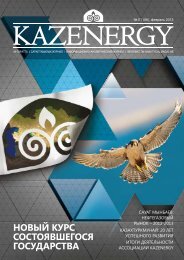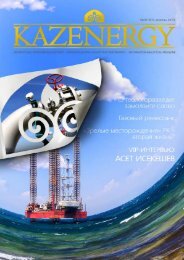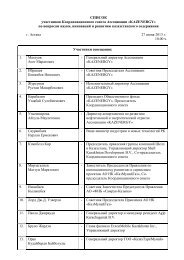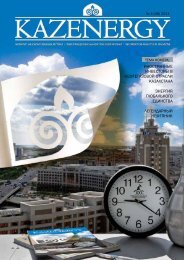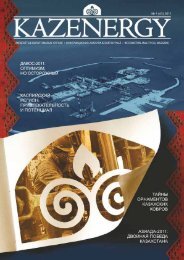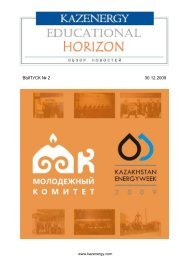â 5 (49), 2011 - KazEnergy
â 5 (49), 2011 - KazEnergy
â 5 (49), 2011 - KazEnergy
- No tags were found...
Create successful ePaper yourself
Turn your PDF publications into a flip-book with our unique Google optimized e-Paper software.
Replacing each other, born the centers of civilization,the ancient people mastered the wood, bone,stone and copper tools, learned how to strikea fire, invented the bow and arrows, weavingmachines, tamed the horse and other animalslearned to plow the ground, created a multifunctional dwelling,the yurt, mastered writing and learned writing and puttingornaments on pottery, created on the rocks their greatworks of art. The planet was changing along with it changedand evolved the human. Some 4000 years ago, and for thehistory it is a moment, the planet was the place for the firsttechnological revolution that is the human inventedthe bronze! Southern Siberia, CentralKazakhstan, the unique Arch are the first ironand steel centres of the earth. "Heavenly Metal"or found an alloy of copper and tin allowedriding a horse hobble, and turn an ordinarysteppe man into the centaur. Mankind has enteredthe era of the iron, the wheel of historyrolled faster.At this time (I thousand BC), in the East, newtribes were forming (see Bichurin N. Ya. [Yakinf],History collection of peoples inhabitedthe Middle Asia in ancient times), empireswere born and died, masterpieces of jewellery were created,the finest silk appeared, beautiful bright fabrics, and at thesame time the struggle for power and territory exacerbateddramatically. China, defending from the countless invasionsof the early Huns nomads, led by the formidable ModeHagan (III-II cc AD) (as Groom Gzhimaylo referred in his"Western Mongolia and Uriankhai edge," Mode in Chinesemeant the transfer of the name Bagatur), built the Greatstone wall, which in our days is clearly visible from space.It is more probable that the Hun tribal alliance was mixed,ethnically heterogeneous: it consisted of Turks, Mongols,Ugric (i.e., ancestors of the Magyars), Khanty and Mansi,and Paleo-Asians. In the "History of the Jin Dynasty," inthe section on the Huns (Huns) from 284 AD, a number oftribes are listed, among which is the tribe named Tu-ge,which was "the most powerful and respected" Scatteredtribes of the Great Steppe: which meant the area of Manchuriaand northern China to the steppes of Kazakhstantoday, after the collapse of the Huns, were united in "dozenof tribes" alliance of Turkic-speaking tribes, which includedKipchaks, Kengerlu, Uighurs, Kalash, Karluk. "When theblue sky was created at the top and the brown earth at thebottom, between both of them there were born the sons ofmankind. Above the sons of mankind, we sat down, the ancestorsof Bumyn Kagan and Istemi Kagan. Having ruledthe kingdom, they guarded the state and established lawsof the Turk people ", so the story about thebeginning of a new era in the desert, the eraof domination of the Turkic tribes, their languagesand the state's largest written monumentto the Turks, a runic inscription in honorof Kyultegin. Thanks to the "high-vehicles" ,carts, as written about them in Chinese chronicles,the technological superiority of the "Altaiblacksmiths' and the use of cataphracts - Platecavalry, nomadic troops and their families itwas possible to manage overcome enormousdistances, wandering to the West. By the way,the scientist Klyashtorny S.G. is convincedthat the term "tele-" is associated with the word "tegreg":Turkic - "cart, wagon." In the last centuries BC and the firstcenturies AD "the tours with fast horses" or, as the fatherof history Herodotus wrote, the "Asian Scythians", the Sarmatians,Saka, Alans, Concarius began assimilating witheach other and settle on the plains of the Eastern Europe.In the academic science this movement of peoples is knownas the Great Migration. But they spoke in genetically relatedlanguages, which are now combined in the Ural-Altaicgroup of languages. The similarity of language, accordingto the chronicle references by Abul-gazy-Bahadur, as wellas researches by Okladnikov, Rudenko, Gumilev, Budbergand Pulliblanc, was reflected to some degree in the similaritybetween the ancient and historical destinies of peoplesgenealogically close-language creators.KAZENERGY111




